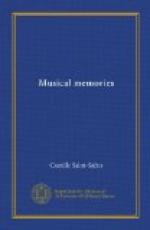The directors of great concerts should love music themselves and should lead the public to appreciate it. They should not allow the masters to be forgotten, for their only fault was that they were not born in our times and they never dreamed of attempting to satisfy the tastes of an unborn generation. Above all, the directors should grant recognition to masters like Joseph Haydn who were in advance of their own times and who seem now and then to belong to our own.
The only examples of Joseph Haydn’s immense work that the present generation knows are two or three symphonies, rarely and perfunctorily performed. This is the same as saying that we do not know him at all. No musician was ever more prolific or showed a greater wealth of imagination. When we examine this mine of jewels, we are astonished to find at every step a gem which we would have attributed to the invention of some modern or other. We are dazzled by their rays, and where we expect black-and-whites we find pastels grown dim with time.
Of Haydn’s one hundred and eighteen symphonies, many are simple trifles written from day to day for Prince Esterhazy’s little chapel, when the master was musical director there. But after Haydn was called to London by Salomon, a director of concerts, where he had a large orchestra at his disposal, his genius took magnificent flights. Then he wrote great symphonies and in them the clarinets for the first time unfolded the resources from which the modern orchestra has profited so abundantly. Originally the clarinet played a humble role, as the name indicates. Clarinetto is the diminutive of clarino, and the instrument was invented to replace the shrill tones that the trumpet lost as it gained in depth of tone.
Old editions of Haydn’s symphonies show a picturesque arrangement, in that the disposition of the orchestra is shown on the printed page. Above, is a group made up of drums and the brass. In the center is a second group—the flutes, oboes and bassoons, while the stringed instruments are at the bottom of the page. When clarinets are used, they are a part of the first group. This pretty arrangement has, unfortunately, not been followed in the modern editions of these symphonies. In the works written in London the clarinet has utterly forgotten its origins. It has left the somewhat plebeian world of the brasses and has gained admittance to the more refined society of the woods. Haydn, in his first attempts, took advantage of the beautiful heavy tones, “chalumeau,” and the flexibility and marvellous range of a beautiful instrument.




